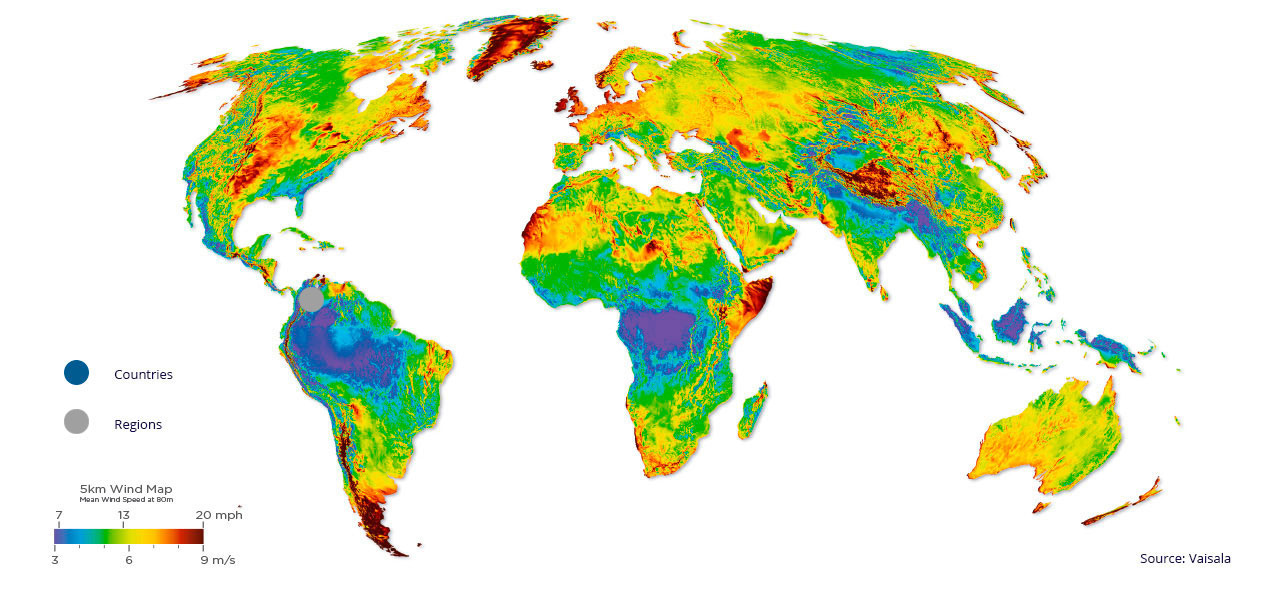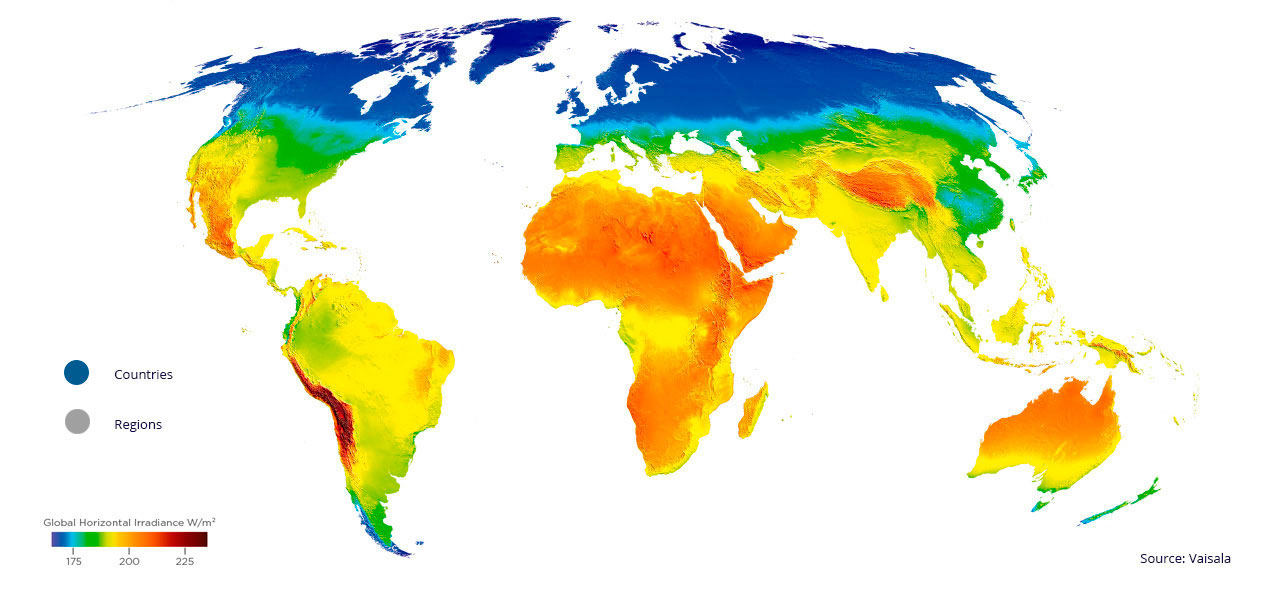Rapidly growing renewables have unquestionably started to transform the global energy landscape in an irreversible way.
Renewables differ in many respects from fossil fuels, and these differences will have geopolitical consequences.
Power shifts
The rapid growth of renewable energy is likely to alter the power and influence of some states and regions relative to others, and to redraw the geopolitical map in the 21st century.
In a renewable energy economy, most countries will be able to achieve energy independence: they will have greater energy security and more freedom to take the energy decisions that suit them. Since some form of economically viable renewable energy potential is available in most places, countries that currently depend heavily on fossil fuel imports will be able to use renewables to reap strategic and economic benefits.


North and South America

United States

North and South America

China

Japan

Russia

India

Nigeria

UAE

Iceland

Morocco

Europe

Middle East and North Africa

Commonwealth of Independent States (CIS)

Sub-Saharan Africa

Small island developing states (SIDS)

South Asia

Small island developing states (SIDS)


North and South America

North and South America

United States

China

Japan

India

Russia

Nigeria

UAE

Iceland

Morocco

Europe

Middle East and North Africa

Commonwealth of Independent States (CIS)

Sub-Saharan Africa

Small island developing states (SIDS)

Small island developing states (SIDS)

South Asia
Countries
The United States is close to energy self-sufficiency largely due to the shale revolution. It became a net exporter of natural gas in 2017 and is projected to become a net oil exporter early in the 2020s.
The country is well positioned in the clean energy race, with US companies holding strong positions in new technologies, including robotics, artificial intelligence, and electric vehicles.
China will gain from the energy transformation in terms of energy security. China has obtained a leading position, not just in the manufacturing, but also in the innovation and deployment of renewable energy technologies. It is the biggest location for renewable energy investment, accounting for than 45% of the global total in 2017. Currently, it is still highly dependent on oil imports that have been growing steadily.
Japan is a major economy with very high fossil fuel import dependency rates. However, the country also holds a strong position in renewable technologies.
India has been among the fastest-growing economies in the world in the last few years, lifting millions out of poverty. India is projected to have the world’s largest population by 2024 and is poised to overtake China as the world’s largest energy growth market by the end of the 2020s. India has set itself an ambitious target of 175GW of renewables by 2022. This represents a massive increase, considering that India’s total installed power generation capacity in October 2018 was only 346GW.
Russia, the world’s largest gas exporter and second largest oil exporter, may face a challenging adaptation to a world increasingly powered by renewables. Russia’s economy is larger and more diversified than any of the Middle Eastern oil producers, but oil and gas rents are a vital component of the state budget, accounting for around 40% of fiscal revenues. Even though Russia is stepping up renewable energy deployment and is investing in research and development, it still lags far behind China and the US in terms of patents for renewable energy technologies.
Nigeria’s high dependence on fossil fuel rents makes its economy vulnerable. It has long struggled with poor governance and poverty, and now faces a youth bulge: the average age of the population is 18 years and the country is expected to overtake the United States to become the third-most populous country in the world by 2050.
The United Arab Emirates (UAE), a major oil-exporting country, has also taken up a leadership position on renewable energy through hosting IRENA and funding renewable energy projects in developing countries via the Abu Dhabi Fund for Development. The UAE is also a major investor in renewable energy projects in developed countries.Economic diversification to reduce dependence on oil rents has been a long-standing policy goal of many oil exporting countries. The economic diversification and decarbonization strategy of the UAE shows how enlightened decision-making can reduce risks. The energy policy of the UAE foresees a 44% share of clean energy and 70% decarbonization of the economy by 2050.
Iceland is a good example of the benefits that can accrue from an economic transformation based on renewables. During the 20th century, Iceland evolved from being one of Europe’s poorest countries, highly dependent on imported coal and oil, to a country with a high standard of living, deriving 100% of its electricity from hydro and geothermal energy. The effective development of its renewables has enabled Iceland to bolster its energy security, widen its economic base and attract new industries to the country, such as aluminium smelting, data storage and greenhouse agriculture.
Morocco currently imports over 90% of the energy it consumes. It plans, however, to exploit its consistent sun and strong winds to reduce these imports and eventually become a net exporter of electricity to European and African markets. It has set a target of 52% renewables in its electricity mix by 2030.
Regions
Europe is a major economy with very high fossil fuel import dependency rates. It also holds strong positions in renewable technologies. Germany leads the way with almost 31,000 renewable energy patents. Germany’s domestic Energiewende, or ‘energy transition’, has made the country a forerunner in terms of renewable energy deployment.
The Middle East and North Africa, together with Russia and other countries in the Commonwealth of Independent States (CIS), are the regions most exposed to a reduction in fossil fuel revenues. On average, these regions have net fossil fuel exports of more than a quarter of their GDP. Declining export revenues will adversely affect their economic growth prospects and national budgets. To prevent economic disruption, they will need to adapt their economies and reduce their dependence on fossil fuels.
Commonwealth of Independent States (CIS) is among the most exposed regions to a reduction in fossil fuel revenues. On average, together with the Middle East and North Africa, these regions have net fossil fuel exports of more than a quarter of their GDP. Declining export revenues will adversely affect their economic growth and national budgets. To prevent economic disruption, these regions will need to adapt their economies and reduce their dependence on fossil fuels.
The majority of countries in Sub-Saharan Africa (SSA) will benefit from reducing fossil fuel imports and generating renewable energy domestically as this will boost job creation and economic growth. The exception to this trend are the two biggest oil producers in the region, Nigeria and Angola, which are at risk because of their high dependence on fossil fuel rents. Because of their size and high dependence on fossil fuel rents, they skew the data for SSA as a region. In the long-term, however, African countries have a unique opportunity to leapfrog the fossil-centred development model despite recent discoveries of oil and gas.
Small island developing states (SIDS) will benefit most of all if they adopt renewable energy sources rather than fossil fuels. The import of fossil fuels now accounts for 8% of their GDP. Many SIDS are also extremely vulnerable to the effects of climate change. SIDS possess ample renewable energy sources and renewable technologies can meet most or all of their domestic energy needs. The shift would cut import bills and promote sustainable development, and increase their resilience. International cooperation to support SIDS’ renewable energy ambitions has grown substantially and 13 SIDS have established between 60-100% renewable energy targets, including Cabo Verde, the Cook Islands, Fiji, Saint Vincent and the Grenadines, Samoa and Vanuatu.
South Asia spends more than 3% of its GDP on the imports of fossil fuels, and has rapidly rising demand for fossil fuels from a low base. These countries will benefit from the energy transformation primarily through reduced fossil fuel import bills, which would otherwise grow dramatically and weigh on these countries’ economies.
Leaders
Countries that are able to take advantage of new renewable energy technologies can expect to enhance their global influence and reach, and become the new leaders.
stand to gain if they are able to become significant exporters of renewable electricity or fuels.
have an opportunity to become part of the global production and value chains necessary for renewable technologies, provided they put the right policies and governance frameworks in place.
are positioned to gain the most from the global energy transformation.
New actors
The renewable energy transformation goes hand in hand with a dispersion of power. New actors will emerge.
As more people install solar panels, batteries and smart software, formerly passive consumers of electricity may become consumers and producers of electricity in an interconnected grid. In this new world of ‘prosumers’, energy assets will no longer be owned exclusively by centralized utilities or the state.
Cities occupy a central role in the energy transformation and have the means to shape the new energy landscape. By 2030, the fifty largest cities will have a bigger economic footprint than many small- and medium-income countries, making them major economic and political players on the international stage in their own right.
Private corporations are responding to the realities of the energy transformation by restructuring and adjusting, and increasing renewables generation. Furthermore, global technology companies are becoming important players in the new energy landscape.
Energy and conflict
The pivot to renewables could reduce the incidence of certain kinds of conflict, and alleviate competition for important natural resources, notably oil, gas, water, and food. On the other hand, cybersecurity and access to important minerals may generate increased concern and tension.
Reduction in oil- and gas-related conflict/
Reduction in oil- and gas-related conflict/
Fossil fuels, especially oil, have made a considerable imprint on patterns of conflict over the last hundred years.
Cybersecurity/
Cybersecurity/
The energy transition is occurring alongside another revolutionary trend: digitalization. New digital technologies are transforming the energy sector by making it more connected, intelligent, efficient, reliable and sustainable.
Minerals/
Minerals/
The widespread adoption of renewable energy and related technologies, such as solar panels, wind turbines, electric vehicles, and energy storage technologies, will increase the demand for a range of minerals and metals required for their production.
Addressing root causes of geopolitical instability
The global energy transformation will affect social, economic and environmental factors that are often among the root causes of geopolitical instability and conflict. Climate change, rapid urbanization, high unemployment, discrimination, inequality and other major trends can create conditions that increase poverty and exclusion, promote the mass movement of people, cause violent conflict, and political extremism—all forces that have the potential to affect geopolitical stability.





